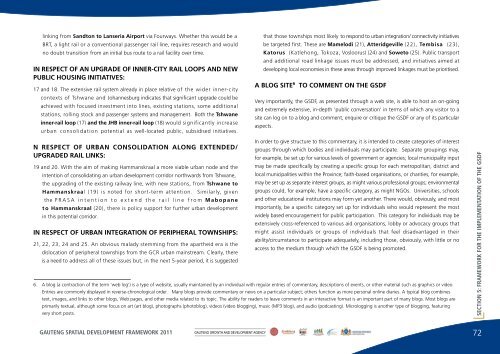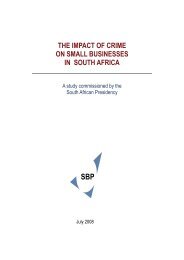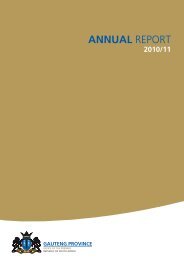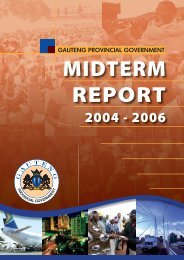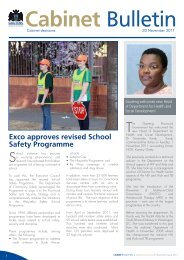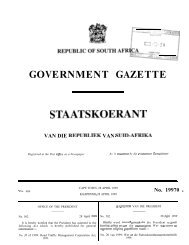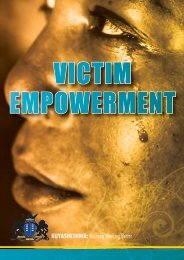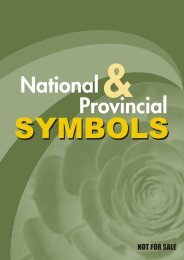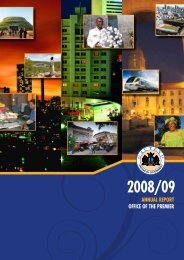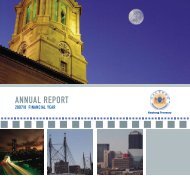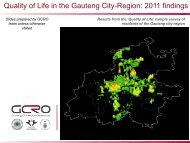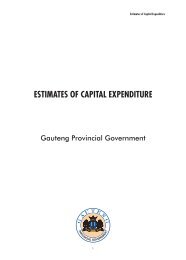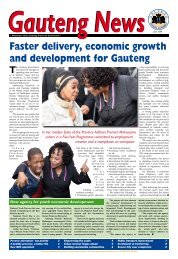the gauteng spatial development framework - Gauteng Online
the gauteng spatial development framework - Gauteng Online
the gauteng spatial development framework - Gauteng Online
You also want an ePaper? Increase the reach of your titles
YUMPU automatically turns print PDFs into web optimized ePapers that Google loves.
linking from Sandton to Lanseria Airport via Fourways. Whe<strong>the</strong>r this would be aBRT, a light rail or a conventional passenger rail line, requires research and wouldno doubt transition from an initial bus route to a rail facility over time.IN RESPECT OF AN UPGRADE OF INNER-CITY RAIL LOOPS AND NEWPUBLIC HOUSING INITIATIVES:17 and 18. The extensive rail system already in place relative of <strong>the</strong> wider inner-citycontexts of Tshwane and Johannesburg indicates that significant upgrade could beachieved with focused investment into lines, existing stations, some additionalstations, rolling stock and passenger systems and management. Both <strong>the</strong> Tshwaneinner-rail loop (17) and <strong>the</strong> JHB inner-rail loop (18) would significantly increaseurban consolidation potential as well-located public, subsidised initiatives.that those townships most likely to respond to urban integration/ connectivity initiativesbe targeted first. These are Mamelodi (21), Atteridgeville (22), Tembisa (23),Katorus (Katlehong, Tokoza, Vosloorus) (24) and Soweto (25). Public transportand additional road linkage issues must be addressed, and initiatives aimed atdeveloping local economies in <strong>the</strong>se areas through improved linkages must be prioritised.A BLOG SITE 6 TO COMMENT ON THE GSDFVery importantly, <strong>the</strong> GSDF, as presented through a web site, is able to host an on-goingand extremely extensive, in-depth 'public conversation' in terms of which any visitor to asite can log on to a blog and comment, enquire or critique <strong>the</strong> GSDF or any of its particularaspects.N RESPECT OF URBAN CONSOLIDATION ALONG EXTENDED/UPGRADED RAIL LINKS:19 and 20. With <strong>the</strong> aim of making Hammanskraal a more viable urban node and <strong>the</strong>intention of consolidating an urban <strong>development</strong> corridor northwards from Tshwane,<strong>the</strong> upgrading of <strong>the</strong> existing railway line, with new stations, from Tshwane toHammanskraal (19) is noted for short-term attention. Similarly, given<strong>the</strong> PRASA intention to extend <strong>the</strong> rail line from Mabopaneto Hammanskraal (20), <strong>the</strong>re is policy support for fur<strong>the</strong>r urban <strong>development</strong>in this potential corridor.IN RESPECT OF URBAN INTEGRATION OF PERIPHERAL TOWNSHIPS:21, 22, 23, 24 and 25. An obvious malady stemming from <strong>the</strong> apar<strong>the</strong>id era is <strong>the</strong>dislocation of peripheral townships from <strong>the</strong> GCR urban mainstream. Clearly, <strong>the</strong>reis a need to address all of <strong>the</strong>se issues but, in <strong>the</strong> next 5-year period, it is suggestedIn order to give structure to this commentary, it is intended to create categories of interestgroups through which bodies and individuals may participate. Separate groupings may,for example, be set up for various levels of government or agencies; local municipality inputmay be made specifically by creating a specific group for each metropolitan, district andlocal municipalities within <strong>the</strong> Province; faith-based organisations, or charities, for example,may be set up as separate interest groups, as might various professional groups; environmentalgroups could, for example, have a specific category, as might NGOs. Universities, schoolsand o<strong>the</strong>r educational institutions may form yet ano<strong>the</strong>r. There would, obviously, and mostimportantly, be a specific category set up for individuals who would represent <strong>the</strong> mostwidely based encouragement for public participation. This category for individuals may beextensively cross-referenced to various aid organisations, lobby or advocacy groups thatmight assist individuals or groups of individuals that feel disadvantaged in <strong>the</strong>irability/circumstance to participate adequately, including those, obviously, with little or noaccess to <strong>the</strong> medium through which <strong>the</strong> GSDF is being promoted.6. A blog (a contraction of <strong>the</strong> term 'web log') is a type of website, usually maintained by an individual with regular entries of commentary, descriptions of events, or o<strong>the</strong>r material such as graphics or video.Entries are commonly displayed in reverse-chronological order. Many blogs provide commentary or news on a particular subject; o<strong>the</strong>rs function as more personal online diaries. A typical blog combinestext, images, and links to o<strong>the</strong>r blogs, Web pages, and o<strong>the</strong>r media related to its topic. The ability for readers to leave comments in an interactive format is an important part of many blogs. Most blogs areprimarily textual, although some focus on art (art blog), photographs (photoblog), videos (video blogging), music (MP3 blog), and audio (podcasting). Micrologging is ano<strong>the</strong>r type of blogging, featuringvery short posts.SECTION 5: FRAMEWORK FOR THE IMPLEMENTATION OF THE GSDFGAUTENG SPATIAL DEVELOPMENT FRAMEWORK 2011GAUTENG GROWTH AND DEVELOPMENT AGENCY72


